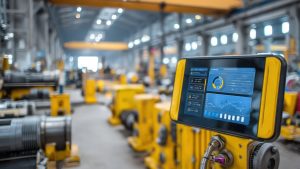Overcoming common maintenance challenges is crucial for businesses. Equipment failures, downtime, and rising maintenance costs affect productivity, profitability, and worker safety. In today’s fast-paced world, outdated methods won’t suffice. Embracing new technologies, like maintenance tracking software, and strategies, such as routine maintenance or predictive maintenance is essential for good maintenance.
Common Maintenance Challenges and AI-Powered Solutions
Maintenance teams face numerous obstacles that hinder operational efficiency. These problems disrupt workflows and compromise performance. Let’s explore some significant challenges:
1. Time-Consuming Manual Data Processing
Many maintenance departments still rely on manual data processing. Engineers waste time sifting through handwritten notes, spreadsheets, and work orders. This inadequate maintenance is a common problem.
According to Reliable Plant, 80% of employees waste 30 minutes every day locating information. AI can automate facts collection and evaluation, supplying actionable insights. This frees up maintenance technicians to focus on other essential maintenance activities.
2. Inefficient Decision-Making Due to Lack of Real-Time Data
Traditional maintenance decisions relied on intuition or historical data. This reactive approach leads to inefficiencies and costly fixes.
Real-time data access enables informed decisions. AI systems with sensors provide real-time insights, preventing problems and minimizing equipment downtime.
Faster decisions improve production and prevent equipment failures. Downtime is a serious issue; for example, OC Transpo reported to CBC missing hundreds of daily trips in one week. Utilizing AI equipment data and implementing regular inspections into maintenance schedules can prevent similar downtime events.
3. Managing Large Datasets and Unstructured Information
Outdated systems struggle with large datasets. Data management becomes chaotic, making information retrieval difficult. This negatively impacts the effectiveness of maintenance plans.
AI analytics helps store, organize, and analyze data efficiently. AI brings order to data management, facilitating informed maintenance processes. This allows maintenance managers to understand complex data quickly and easily.
4. Lack of Scalability in Current Maintenance Systems
Growing businesses need adaptable systems. While current maintenance programs might suffice now, they may not support future needs. Expanding businesses often require specialized knowledge from technicians.
Cloud-based AI solutions offer scalability. As your company grows, AI ensures your maintenance plan keeps pace with production. Regular inspections and a well-defined preventive maintenance program will help reduce downtime.
5. Limited Team Collaboration and Data Silos
Many maintenance teams work in silos, hindering collaboration and information sharing. This leads to duplicated efforts and missed opportunities for improvement.
AI-powered systems facilitate real-time collaboration. They break down data silos, enabling information sharing and open communication. Good maintenance is a team effort, so proper communication among team members helps ensure everyone is on the same page. Having an established process for handling equipment maintenance and following detailed maintenance procedures will greatly improve safety.
Overcoming Common Maintenance Challenges with AI
Maintaining a skilled workforce is difficult. Investing in worker training increases retention and prepares employees for various tasks. This allows for flexible resource allocation.
Tracking maintenance across diverse equipment is another challenge. Tools like UpKeep’s Maintenance Management streamline maintenance programs. Proactive monitoring and scheduled repairs minimize unplanned downtime. A lack of regular maintenance for electrical systems can severely disrupt workflow.
AI addresses many problems faced by modern maintenance teams. Services like Universal Fleet Solutions (UFS) assist with equipment upkeep management. Maintenance managers benefit greatly from these programs as well as by attending specialized training themselves. This specialized knowledge from technicians makes it much easier to track maintenance for large collections of machinery.
Predictive maintenance leverages AI to predict and address equipment failures. Maintenance costs often benefit from moving away from a costly reactive maintenance model and implementing more preventive measures to reduce downtime and minimize expensive repairs.
High worker turnover poses additional challenges, disrupting maintenance schedules. Creating a supportive work environment and addressing labor shortages will stabilize the workforce. A maintenance technician is only as good as their equipment and resources available. Ensuring access to required equipment improves efficiency and productivity.
Implementing AI can enhance your current work order system to reduce confusion and minimize labor needed. By optimizing maintenance strategies, AI helps businesses overcome maintenance problems, reduce downtime, increase equipment lifespan, and improve productivity. Implementing the right AI tools improves safety while addressing common maintenance issues.
Conclusion
Overcoming common maintenance challenges requires a proactive approach to ensure smooth and efficient maintenance operations. AI-powered solutions play a crucial role in identifying potential issues before they escalate, improving decision-making, and streamlining daily processes. By leveraging advanced tracking software and proactive work order systems, businesses can achieve higher levels of efficiency, reduce downtime, and optimize resource utilization.
Addressing these challenges not only enhances worker productivity and safety but also contributes to overall profitability. AI-driven automation simplifies traditionally manual tasks, facilitates better collaboration between maintenance teams, and ensures seamless communication, leading to well-coordinated operations.
In modern maintenance operations, streamlining workflows is often overlooked, yet it plays a critical role in ensuring the proper implementation, tracking, and execution of maintenance procedures. AI solutions empower businesses to embrace predictive and preventative maintenance strategies, minimizing the risk of unexpected failures and reducing reliance on specialized technicians. By integrating AI into maintenance processes, organizations can create more resilient operations that are adaptive to changing business needs.



